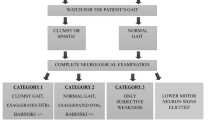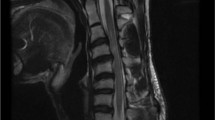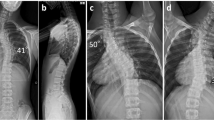Abstract
Introduction
Delayed C5 weakness is a known entity in cervical spine surgery, although with varied clinical presentation and poorly understood mechanism of action. We describe the first case in the literature of a bilateral C5 palsy leading to bilateral phrenic nerve dysfunction following a posterior cervical decompression and fusion.
Case report
A 76-year-old male presented with low back pain and was diagnosed as myelopathic. On initial neurological examination, he could not ambulate without assistance and was unsteady on tandem gait. The initial cervical MRI and CT scan showed advanced multilevel degenerative changes of the cervical spine with severe cord compression and myelomalacia. The patient underwent C3-C6 posterior cervical decompression & fusion (PCDF). He awoke with his baseline examination without neurophysiological monitoring changes intraoperatively or C5 root EMG activity. Post-operative MRI of the cervical spine was performed and showed an excellent decompression. The patient was neurologically stable and discharged to a rehabilitation facility. Patient developed a delayed bilateral C5P on postoperative day (POD) 74. Delayed bilateral C5P and phrenic nerve damage was determined to cause this patient’s dyspnea. PM&R consult recommended placement of diaphragmatic pacers. However, clinically his respiratory function, as well as motor deficits, have gradually improved.
Conclusion
Bilateral diaphragmatic paralysis, a severe complication of cervical spine surgery, may cause respiratory distress and upper limb weakness. C5P, the underlying cause, may arise from various factors. Early detection and management of diaphragmatic weakness with physical therapy and pacers are crucial, emphasizing the need for vigilance by healthcare professionals and surgeons.
This is a preview of subscription content, access via your institution
Access options
Subscribe to this journal
Receive 1 print issues and online access
We are sorry, but there is no personal subscription option available for your country.
Buy this article
- Purchase on Springer Link
- Instant access to full article PDF
Prices may be subject to local taxes which are calculated during checkout

Similar content being viewed by others
Data availability
All data supporting the findings of this study are available within the article.
References
Singh SK. The cervical plexus: anatomy and ultrasound guided blocks. Anaesth Pain & Intensive Care. 2015;19:323–32.
Rajabian A, Quraishi NA. C5 palsy after cervical spine decompression: topographic correlation with C6 chassaignac tubercle?: A fresh-cadaveric study of the cervical spine and rediscussion of etiological hypotheses. Spine. 2020;45:E903–8.
Sakaura H, Hosono N, Mukai Y, Ishii T, Yoshikawa H. C5 palsy after decompression surgery for cervical myelopathy: review of the literature. Spine. 2003;28:2447–51.
Usami Y, Yokota A, Kondo Y, Neo M. Morphology of cervical periradicular fibrous sheath and nerve roots in relation to postoperative C5 palsy. Spine J. 2022;22:690–6.
Zheng C, Nie C, Zhu Y, Xu M, Lyu F, Jiang J, et al. Preoperative electrophysiologic assessment of C5-innervated muscles in predicting C5 palsy after posterior cervical decompression. Eur Spine J. 2021;30:1681–8.
Youssef JA, Heiner AD, Montgomery JR, Tender GC, Lorio MP, Morreale JM, et al. Outcomes of posterior cervical fusion and decompression: a systematic review and meta-analysis. Spine J. 2019;19:1714–29.
Moon AS, Pearson JM, Pittman JL. Phrenic nerve palsy after cervical laminectomy and fusion. North Am Spine Soc J. 2020;4:100022.
Fujibayashi S, Shikata J, Yoshitomi H, Tanaka C, Nakamura K, Nakamura T. Bilateral phrenic nerve palsy as a complication of anterior decompression and fusion for cervical ossification of the posterior longitudinal ligament. Spine 2001;26:e281–6.
Park H-Y, Kim K-W, Ryu J-H, Lim C-R, Han S-B, Lee J-S. Cervical foraminal stenosis causing unilateral diaphragmatic paralysis without neurologic manifestation: a case report and review of the literature. Medicine. 2020;99:e20798.
O’Beirne SL, Chazen JL, Cornman-Homonoff J, Carey BT, Gelbman BD. Association between diaphragmatic paralysis and ipsilateral cervical spondylosis on MRI. Lung. 2019;197:727–33.
Tsou P, Yeung CA, Yeung A. The spine journal: official journal of the North American Spine Society. Spine J. 2004;4:564–73.
Houten JK, Buksbaum JR, Collins MJ. Patterns of neurological deficits and recovery of postoperative C5 nerve palsy. J Neurosurg. Spine. 2020;33:742–50.
Jack AS, Osburn BR, Tymchak ZA, Ramey WL, Oskouian RJ, Hart RA, et al. Foraminal ligaments tether upper cervical nerve roots: a potential cause of postoperative C5 palsy. J Brachial Plex Peripher Nerve Inj. 2020;15:e9–15.
Abola MV, Knapik DM, Hamparsumian AA, Marcus RE, Liu RW, Gordon ZL. Relationship between foraminal area and degenerative changes in the lower cervical spine with implications for C5 nerve root palsy. Orthopedics. 2018;41:e506–e10.
Hitchon PW, Moritani T, Woodroffe RW, Abode-Iyamah K, El Tecle NE, Noeller J, et al. C5 palsy following posterior decompression and instrumentation in cervical stenosis: single center experience and review. Clin Neurol Neurosurg. 2018;174:29–35.
Andelman SM, McAnany SJ, Qureshi SA, Hecht AC. Bilateral C5 motor palsy after anterior cervical decompression and fusion: A case report and review of the literature. Int J Spine Surgery. 2017;11:99–104.
Planchard RF, Maloney PR, Mallory GW, Puffer RC, Spinner RJ, Nassr A, et al. Postoperative delayed cervical palsies: understanding the etiology. Glob Spine J. 2016;6:571–83.
Komagata M, Nishiyama M, Endo K, Ikegami H, Tanaka S, Imakiire A. Prophylaxis of C5 palsy after cervical expansive laminoplasty by bilateral partial foraminotomy. Spine J. 2004;4:650–5.
Yamasaki Y, Takeuchi K, Numasawa T, Wada K, Itabashi T, Kumagai G, et al. Can prophylactic C4/5 foraminotomy prevent C5 palsy after cervical laminoplasty with and without posterior instrumented fusion with maximal expansion? Eur J Orthop Surg Traumatol. 2021;31:1037–46.
Singhatanadgige W, Limthongkul W, Valone F 3rd, Yingsakmongkol W, Riew KD. Outcomes following laminoplasty or laminectomy and fusion in patients with myelopathy caused by ossification of the posterior longitudinal ligament: a systematic review. Glob Spine J. 2016;6:702–9.
Durand WM, Daniels AH. C4 root compression leads to phrenic nerve palsy with shortness of breath, chest pain, and elevated hemidiaphragm. Lancet. 2020;396:1101.
Houten JK, Buksbaum JR, Collins MJ. Patterns of neurological deficits and recovery of postoperative C5 nerve palsy. J Neurosurg Spine. 2020:1–9.
Miller JA, Lubelski D, Alvin MD, Benzel EC, Mroz TE. C5 palsy after posterior cervical decompression and fusion: cost and quality-of-life implications. Spine J. 2014;14:2854–60.
Oh JK, Hong JT, Kang DH, Kim S-W, Kim SW, Kim YJ, et al. Epidemiology of C5 palsy after cervical spine surgery: a 21-center study. Neurospine. 2019;16:558.
Chow J, Hatem M. Quantitative analysis of diaphragm motion during fluoroscopic sniff test to assist in diagnosis of hemidiaphragm paralysis. Radiol Case Rep. 2022;17:1750–4.
Rahimizadeh A, Amirzadeh M, Rahimizadeh S, Hajialiloo Sami S, Rahimizadeh S, Asgari N, et al. Bilateral C5 palsy following a circumferential surgery for cervical spondylotic myelopathy: a case report and review. Iran J Neurosurg. 2021;7:205–12.
Kaufman MR, Bauer T, Onders RP, Brown DP, Chang EI, Rossi K, et al. Treatment for bilateral diaphragmatic dysfunction using phrenic nerve reconstruction and diaphragm pacemakers. Interact Cardiovasc Thorac Surg. 2021;32:753–60.
Acknowledgements
The authors sincerely thank the participants. Additionally, we extend our gratitude to Sara Thalheimer for her invaluable assistance in the completion of this case report.
Author information
Authors and Affiliations
Contributions
GAG: Conceptualization, Methodology, Formal analysis, Writing e original draft. JM: Methodology, Formal analysis, Writing e original draft. GP: Methodology, Formal analysis, Writing e original draft. JH: Supervision.
Corresponding author
Ethics declarations
Competing interests
The authors declare no competing interests.
Statement of ethics
Patient consent was not required per our IRB. We certify that all applicable institutional regulations concerning the ethical use of human volunteers were followed during the course of this project.
Additional information
Publisher’s note Springer Nature remains neutral with regard to jurisdictional claims in published maps and institutional affiliations.
Supplementary information
Rights and permissions
Springer Nature or its licensor (e.g. a society or other partner) holds exclusive rights to this article under a publishing agreement with the author(s) or other rightsholder(s); author self-archiving of the accepted manuscript version of this article is solely governed by the terms of such publishing agreement and applicable law.
About this article
Cite this article
Gonzalez, G.A., Miao, J., Porto, G. et al. Bilateral phrenic nerve palsy after posterior cervical decompression and fusion surgery: a rare event after surgery. Spinal Cord Ser Cases 9, 41 (2023). https://doi.org/10.1038/s41394-023-00595-1
Received:
Revised:
Accepted:
Published:
DOI: https://doi.org/10.1038/s41394-023-00595-1



